
During recent adjustments to the default neural parameters, however, this default herbivore was left with negative values for the 'drift' parameter in most of its neurons and this left it with a disinclination to breed and grow. In fact, the herbivore provided with early versions of e-den tended to become extinct.
The first step, then, in creating viable samples, was to adjust the drift parameters for neurons #006 and #008, the neurons responsible for extending and sporing. The adjustments were achieved in the Bug Lab (a crude genome designer supplied with e-den) and the resulting organism was saved as sample.gnm.
Second, to create smart.gnm, each main motor neuron (east #002, south #003, west #004 and north #005) was given inhibitory axons linked to the other motor neurons... This meant that the organisms, once travelling in a certain direction, had a slight preference for continuing in the same direction, leading to more decisive movement and less jiggling on the spot. The organisms were also given inhibitory axons leading from the "grass-seeing" neurons (#101, #126 etc) to the motor neurons of the opposite direction (#004 for #101, #005 for #126 etc...) Note that, to achieve this using the "visual neurons" gene type, it was only necessary to specify the connection for the generic visual neuron #01 (facing east by convention) to the west motor neuron (#004), and the relationship was automatically applied to the other grass-seeing neurons (try decoding the genome to see how this was done or visit the syntax page). Similarly, excitatory links were placed between the "grass-seeing" neurons and the motor neurons of the same direction (#002). This gave the organism a preference for movement towards grass, leading to more efficient grazing.
To create shy.gnm, a smart.gnm organism was selected and modified in the Bug Lab by putting an inhibitory link between the three-seeing visual neurons and the motor neurons of the same direction. This modification reduces the chance of an organism colliding with one of its own children and encourages families to spread out... The strength of the link is probably far from optimal but evolution should fine tune it.
Finally, the grass-seeking connections were boosted, with some adjustments of the sensitivity of the grass-seeing neurons. It's not yet clear whether these were improvements but the result was saved as smarter.gnm.
If you load sparse.wld, you will see a single organisms devouring a clump of grass in an otherwise empty world. Although it clearly hones in on grass quite well in this setting, it performs less well when it has grass on all sides, as it is drawn in several directions at once. I suspect this organism would benefit from an inhibitory connection from one grass-seeing neuron to the next, encouraging it to focus its attention on the closest grass.
All three of these recently designed genomes have shown the ability to propogate from a single forebear under the following recommended settings:
climate: fixed at 100
difficulty: 20 per 1000 (v0.54) or 2 per 100 (v0.52 or v0.53)
world structure: blank plus 2-4 "cluster insertions" of -7 atoms
background mutation rate: 5
organism defaults: ON
After experimenting with those parameters, you are invited to make things more difficult by slowly increasing the difficulty, decreasing the climate, adding more inanimate clusters and so on. (Please send me any gene pools you manage to obtain that are 100-500 generations old, with a note on the conditions they evolved in. I plan to pool them all and keep the survivors.)
Below, I relate my own experience with these sample organisms.
All the worlds are related and have the same underlying inorganic structure: they are framed with nine-atoms and have a few random barriers constructed of seven-atoms. These barriers were created with the mouse by clicking the yellow digital-insert button and then dragging the cursor across the World window. In retrospect, these barriers were a little too close at some points and the current crop of organisms had difficulty making use of the full territory.

The first world shown was initially set in motion with the climate set to 100, the mutation rate set to 5, the difficulty set at 2/100 (equivalent to 20/1000 in the latest version) and the world completely filled with grass. A single organism was placed near the middle of the world, using the file "smarter.gnm" (contained in the samples file, and discussed in some detail on the download page). After one false start, where the organism collided and died, a second organism was added and it soon produced a population of about 10. Because of the improved grazing efficiency exhibited by the smarter.gnm organisms, the available grass nearby was quickly consumed and population growth proceeded at the edges of the cluster of organisms, at points where the barriers allowed movement into new grazing areas. The organisms showed a strong tendency to avoid the barriers of seven-atoms and a consistent pattern over the next 50 generations was limited local population expansion, followed by depletion of local resources, then exploration of a new, well-grassed area by a single roaming organism who founded a new population expansion as the original group died off. Thus, evolution proceeded through intermittent bottlenecks every 10 to 20 generations, with each bottle-neck consisting of a single organism who managed to find a new field. It would be nice to think that this caused selection for roaming exploratory behaviour but, in most cases, the single organism was successful because it happened to be in the right place at the right time. It would take a longer period of evolution, probably in distributed mode, before this obvious selective pressure translated itself into successful neural mutations.
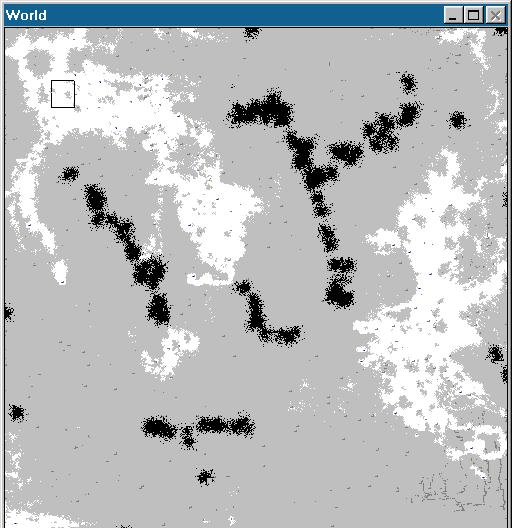
At times waning populations made it necessary to increase the climate to 120 or 150 and decrease the difficulty. After a period in which the population waxed and waned between 30 and 50, e-den was inadvertently left running with the "organism defaults" option turned OFF. This gave the organisms random values for metab-div and metab-child, two parameters that determine, respectively, how much metabolic fuel is reserved for the parent at the time of sporulation and how much is passed on to the spore. Sporulation cannot procede unless the metabolic fuel levels exceed the sum of metab-div and metab-child. The random values provided for the organisms were, on the whole, way too high and reduced the breeding rate of the organisms. A severe decline in population numbers occurred. At the same time, clumps of two-atoms were beginning to appear where previous organisms had died. The organisms were seeing these as patches of non-grass, not worth moving towards and so they were beginning to get hemmed in by the clumps; their limited exploratory tendencies were overcome. The scene was ripe for a simpler competitor to arise and, in the world below, it can be seen that simple blind mutant, consisting of a single 3-segment, has appeared in the lower left corner.
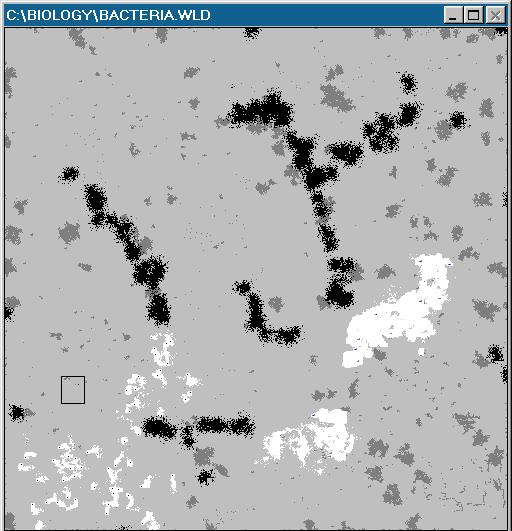
The mutant is one of the simplest possible e-den organisms. Because they didn't see and therefore didn't avoid the clumps of two-atoms, the mutants did not become hemmed in and enjoyed the benefit of eating atoms twice as energetically valuable as grass. Furthermore, by grazing randomly and inefficiently, they left plenty of grass to grow back and thus did not deplete local resources; they could exist at a higher population density for any given climate than their more complex, efficient cousins. (This paradox obviously has many counterparts in real biology).
The disadvantages of being blind - namely running into obstacles and being unaware of predators - would severely limit the successes of this simple mutant in the long term. Furthermore, their small size would tend to make them the automatic loser in any collision. But they happened to arise, in this example, in a region devoid of significant competitors, at a time when the other major species was running into difficulties. From the position saved in the world above, the original species twice fell into extinction, despite restoring the "organism defaults" and adjusting the climate. The simpler species (I called them "bacteria" and saved one as bacteria.gnm) took over the world both times.
Convinced that the bacteria were, in fact, inferior, I cheated to prove the point. I placed a single spore, derived from one of the surviving smarter.gnm organisms, in the midst of the simpler mutants and it promptly grew, survived its collisions with the smaller competitor, munched the grass more efficiently and starved the bacteria out. The result is shown below. (If e-den had been running in distributed mode, I strongly suspect that I wouldn't have had to cheat; an imigrant organism from a neighbouring grid would have eventually entered and displaced the bacteria, perhaps even hunted them down.)
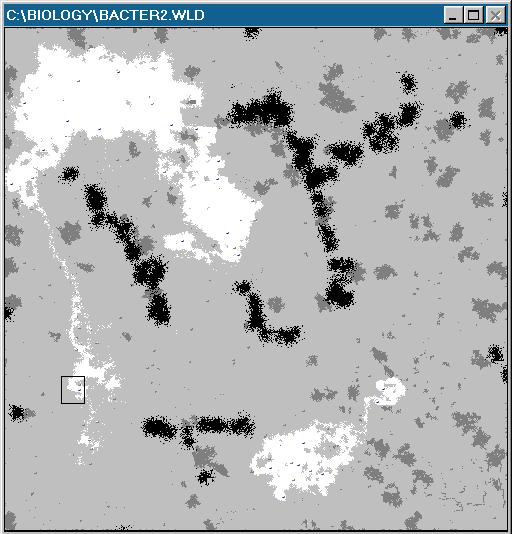
One of the original problems faced by my smarter.gnm organisms remained, however, and became extreme as time progressed. Growing clumps of two and three-atoms, rather than being recognised as fine, energy rich food sources, were avoided and the organisms found themselves crowded out.
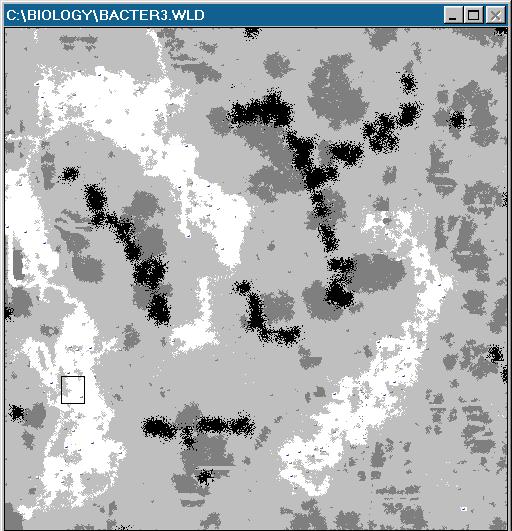
Ultimately, I had to turn the climate up to preserve population numbers and this removed selective pressures on clever grazing. Rather than continue in the vain hope that one of the organisms would realise it could eat 2s and 3s, I chose a promising looking organism and modified it so that it had a tendency to move towards 2s and 3s. I then reset the world, killing all organisms but keeping the physical structure unchanged, and inserted a single spore of my improved species. Within a minute or two it had produced several offspring and was on its way to re-colonising the world, this time eating the clumps of 2s and 3s.
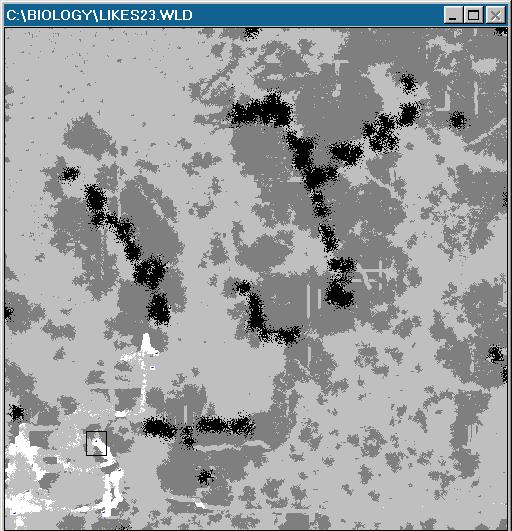
The major fault with this organism, however, was that it made no attempt to avoid its children and siblings. The organisms tended to collide and destroy each other. I therefore made another couple of modifications and introduced the new versions in uninhabited regions of the world, as you'll see if you examine the worlds below. It is too early to say which of the various organisms is likely to dominate... Clearly, these herbivores are still over-intimidated by the barriers and fail to spread out and use the available territory. They do, however, make better use of the two-clumps that tend to accumulate in mature worlds. Work at improvements will continue and then I will attempt to create a viable carnivore.
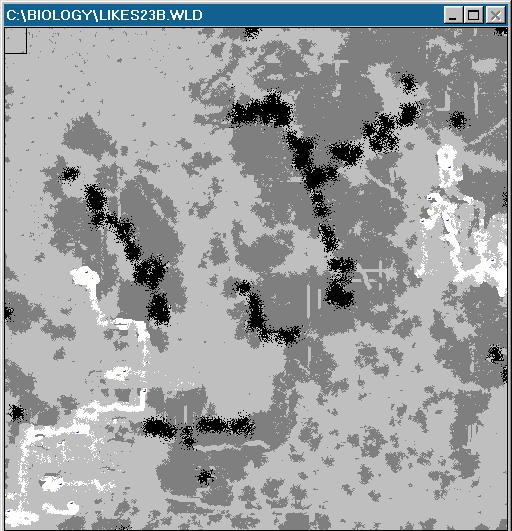
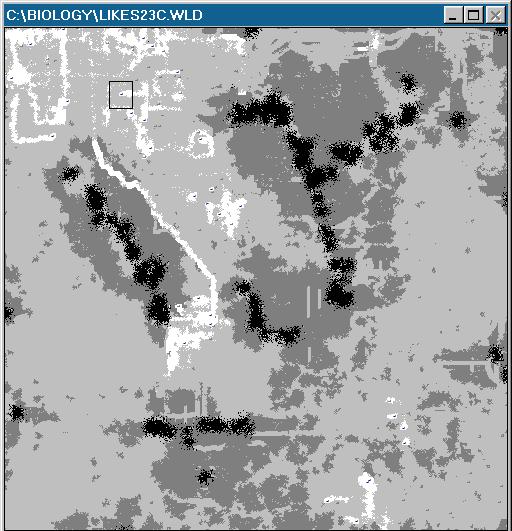
Contents |
e-den introduction | e-den overview | e-den physics | e-den biology | e-den neurology | e-den genetics | e-den across cyberspace | e-den user interface | e-den FAQ |